What kind of flowers or trees are commonly seen in Vietnam? Vietnam’s diverse landscapes boast a stunning array of flora, from vibrant flowers to towering trees, making it a botanist’s paradise and a visual treat for travelers. SIXT.VN is here to guide you through the most commonly seen and captivating species. Discover the natural beauty of Vietnam and enhance your travel experience by learning about its unique plant life.
1. What Flowers And Plants Are Commonly Seen in Vietnam?
Many flowers and plants are commonly seen in Vietnam. Vietnam’s rich biodiversity means you’ll encounter a variety of stunning flowers and lush plants throughout your travels. Here are some of the most frequently spotted and beloved floral species:
1.1 Frangipani (Hoa Sứ, Plumeria)
 Frangipani flower, Vietnam
Frangipani flower, Vietnam
This milky white flower with a yellow tinge boasts a captivating citrusy and sweet scent, predominantly found in the south, south-central, and central coast, as well as the Mekong Delta. The Vietnamese name, hoa sứ, translates to “porcelain flower,” referring to its pristine white color.
1.2 African Tulip (Spathodea)
 African Tulip tree, Vietnam
African Tulip tree, Vietnam
The African Tulip, with its brilliant red-orange flowers resembling lanterns, is a medium-sized tree that thrives in the Mekong Delta and along the southern and central coasts, especially during the dry season (November to May). It’s often planted in coastal resorts for its aesthetic charm.
1.3 Lantana (Ngũ Sắc)
 Lantana flower, Vietnam
Lantana flower, Vietnam
This small flower, growing on a shrub-like bush, is commonly found in coastal regions, particularly in the south and central areas. Its flowers display a bouquet of colors, living up to its Vietnamese name, ngũ sắc, which means “five colors.” The textured leaves emit a pleasant scent reminiscent of essential oils.
1.4 Hibiscus (Chi Râm Bụt)
 Hibiscus flower, Vietnam
Hibiscus flower, Vietnam
Hibiscus, a beautiful flower available in numerous colors and sizes, is abundant in the tropical south, along the coast, and in the highlands. These shapely, delicate flowers, often seen in Buddhist temples and beach resorts, symbolize the transience of life.
1.5 Rangoon Creeper (Sử Quân Tử, Chinese Honeysuckle)
 Rangoon creeper vine, Vietnam
Rangoon creeper vine, Vietnam
The Rangoon Creeper, also known as Chinese honeysuckle, exudes a seductive aroma and grows as a vine on walls and entrances in coastal and midland regions. Its delicate flowers bloom in pink, purple, and white, creating a delightful and irresistible spectacle.
1.6 Bougainvillea (Hoa Giấy)
 Bougainvillea, Vietnam
Bougainvillea, Vietnam
Bougainvillea, with its vibrant pink, purple, and white petals, thrives in the coastal regions of the southern and central provinces, as well as the Central Highlands. Known as hoa giấy or “paper flower” in Vietnamese, its fine, translucent petals create a hypnotic, joyful, and magnetic presence.
1.7 Sweet Pea (Hoa Hương Đậu)
 Sweet Pea flower, Vietnam
Sweet Pea flower, Vietnam
Sweet Pea, with its delicate purple, white, and pink flowers and glorious fragrance, is one of the prettiest and most seductive flowers, although rare. Primarily found in the Southern Central Highlands, especially in Dalat, it adorns former French colonial villas.
1.8 Crown Flower (Chi Bòng Bòng)
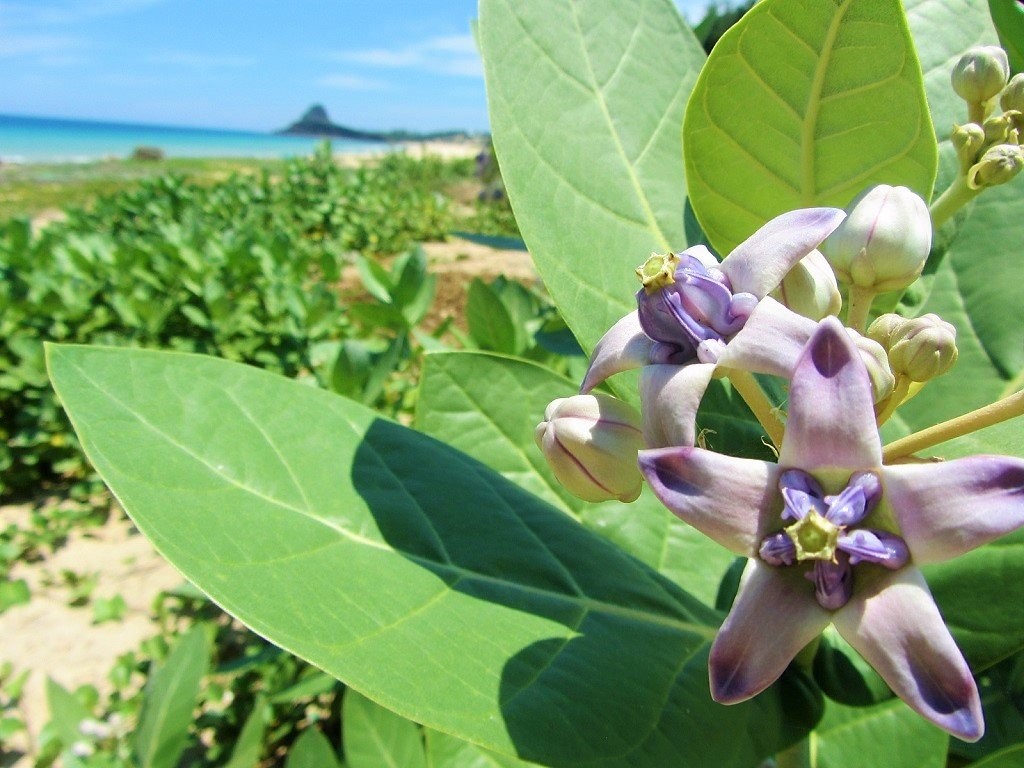 Crown flower, Vietnam
Crown flower, Vietnam
The Crown Flower, a distinctive white and violet, star-shaped flower, is a common sight along Vietnam’s coastline. This bush-like plant grows like a weed along sandy beaches, with stiff, shiny leaves and flowers, featuring a five-sided stigma that resembles a royal crown.
1.9 Spider Lily (Hymenocallis)
 Spider Lily, Vietnam
Spider Lily, Vietnam
The Spider Lily, named for its spindly tentacles, showcases pretty, decorative lilies in gardens along the coast and in the Central Highlands. These delicate, snow-white flowers have a slight perfume, though some find their shape slightly sinister.
1.10 Angel’s Trumpet (Datura)
 Angel
Angel
Angel’s Trumpet, a bush displaying dozens of large, colorful, tubular flowers, is a remarkable sight in the highlands and coastal regions. With prolific bushes exhibiting over fifty flowers at once, it’s particularly prevalent during the southern dry season.
1.11 Yellow Mimosa (Acacia, Cây Keo Bạc)
 Yellow Mimosa (Acacia) flower, Vietnam
Yellow Mimosa (Acacia) flower, Vietnam
Yellow Mimosa, a medium-sized tree with silver-grey leaves and bright yellow flowers, thrives in Vietnam’s Central Highlands. In Dalat, its romantic associations make it a popular name for hotels, cafes, and parks. The Vietnamese name, Cây Keo Bạc, translates to “silver glue tree,” referring to its leaves and sticky sap.
1.12 Water Lily (Hoa Súng)
 Purple water lily, Vietnam
Purple water lily, Vietnam
The Water Lily, with its bewitching precision and perfection, graces lakes and ponds in the Mekong Delta and coastal regions. In Vietnam, these flowers aren’t only decorative but also a source of sustenance, particularly in bún mắm, where the stems are used as a garnish.
1.13 Flame Vine (Flaming Trumpet, Hoa Chùm Ớt, Hoa Rạng Đông)
 Flame vine, Vietnam
Flame vine, Vietnam
The Flame Vine, an animated, bright, and playful creeper, brightens even the grayest days in the Central Highlands. Thousands of little, tubular, bright orange or red flowers pop out from the green leaves, making it a theatrical and showy plant.
1.14 Madagascar Periwinkle (Dừa Cạn)
 Madagascar Periwinkles, Vietnam
Madagascar Periwinkles, Vietnam
Madagascar Periwinkles grow like a weed along Vietnam’s coastline, thriving in hot, salty, and windy conditions. These pretty little flowers line sandy beaches, sprout between rocks, and reclaim abandoned resort construction sites.
1.15 Yellow Oleander (Chi Thông Thiên)
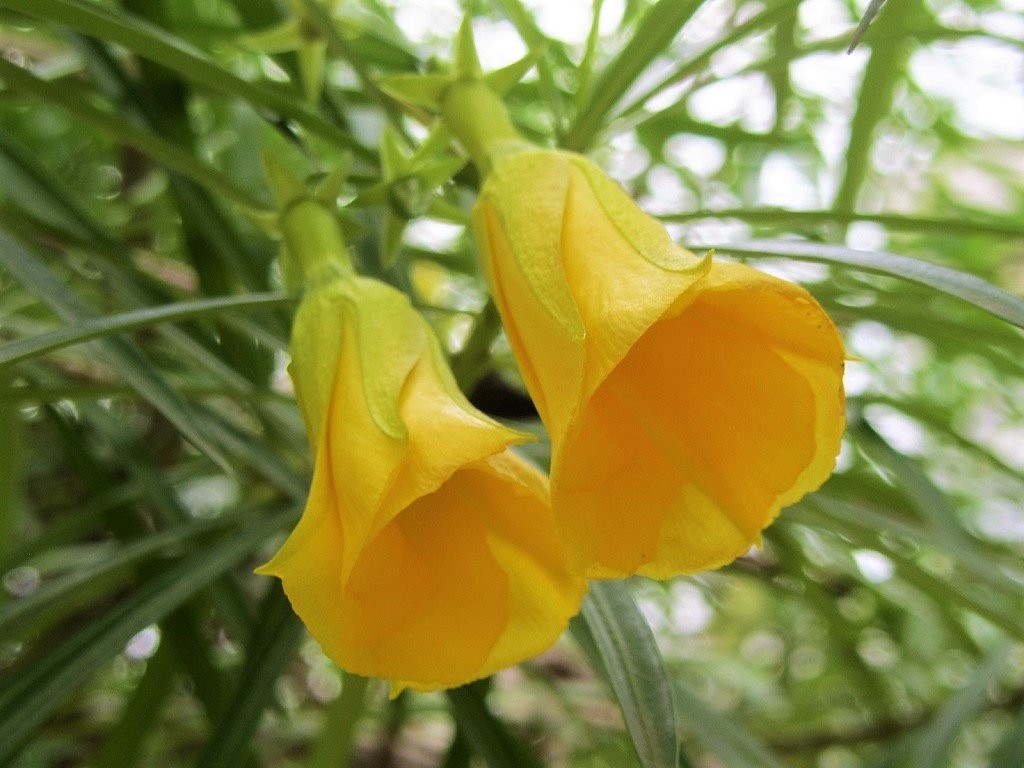 Yellow Oleander flower, Vietnam
Yellow Oleander flower, Vietnam
Yellow Oleander, with its neat, bell-shaped flowers and skinny, grey-green leaves, grows in gardens in the Central Highlands and along highway partitions in southern coastal cities. Despite their pretty appearance, Yellow Oleander is toxic to animals and humans.
1.16 Orchid Tree (Purple Bauhinia, Móng Bò Tím, Hoa Ban)
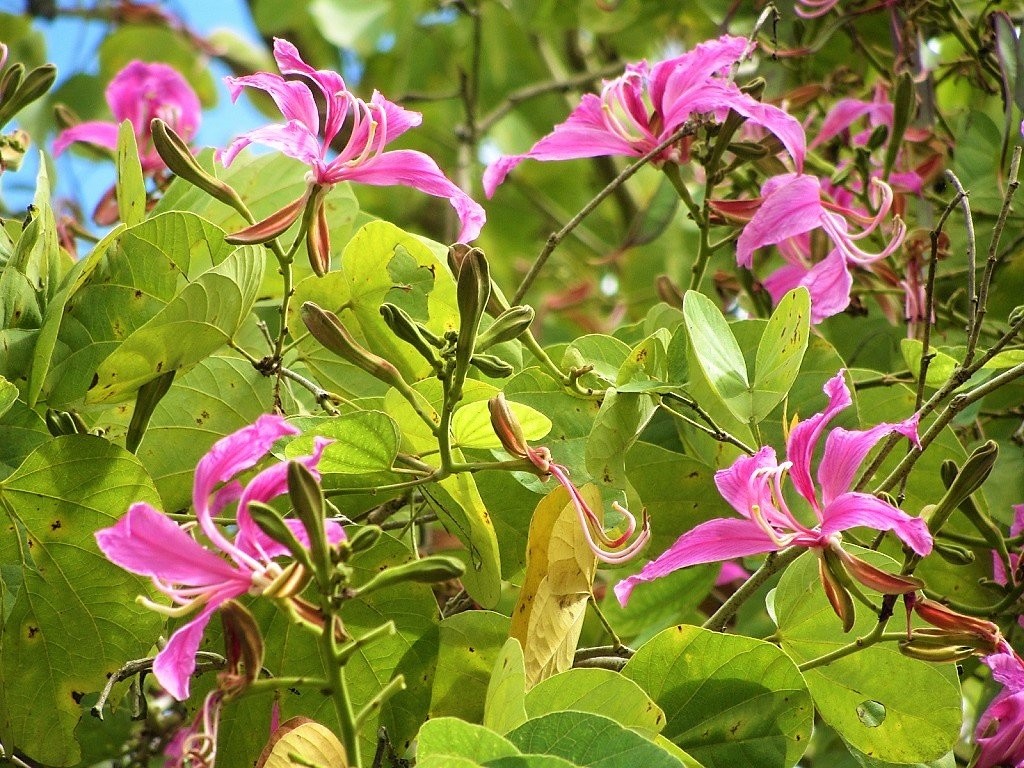 Orchid Tree, Vietnam
Orchid Tree, Vietnam
The Orchid Tree, with its pink-purple flowers, is associated with cool, clear days in Dalat during the dry season. These trees decorate gardens and resorts along the tropical coast, offering fuller and more shapely flowers than potted orchids.
1.17 Ixora (Jungle Geranium, Chi Trang, Cẩm Tú Cầu)
 Ixora flower, Vietnam
Ixora flower, Vietnam
Ixora, also known as Jungle Geranium, is a neat and decorative bush often seen in the Central Highlands. Its flowers grow in large clusters of one color, with many varieties ranging from deep red to sky blue, resembling cheerleaders’ pompoms.
1.18 Lipstick Tree (Annatto, Điều Màu)
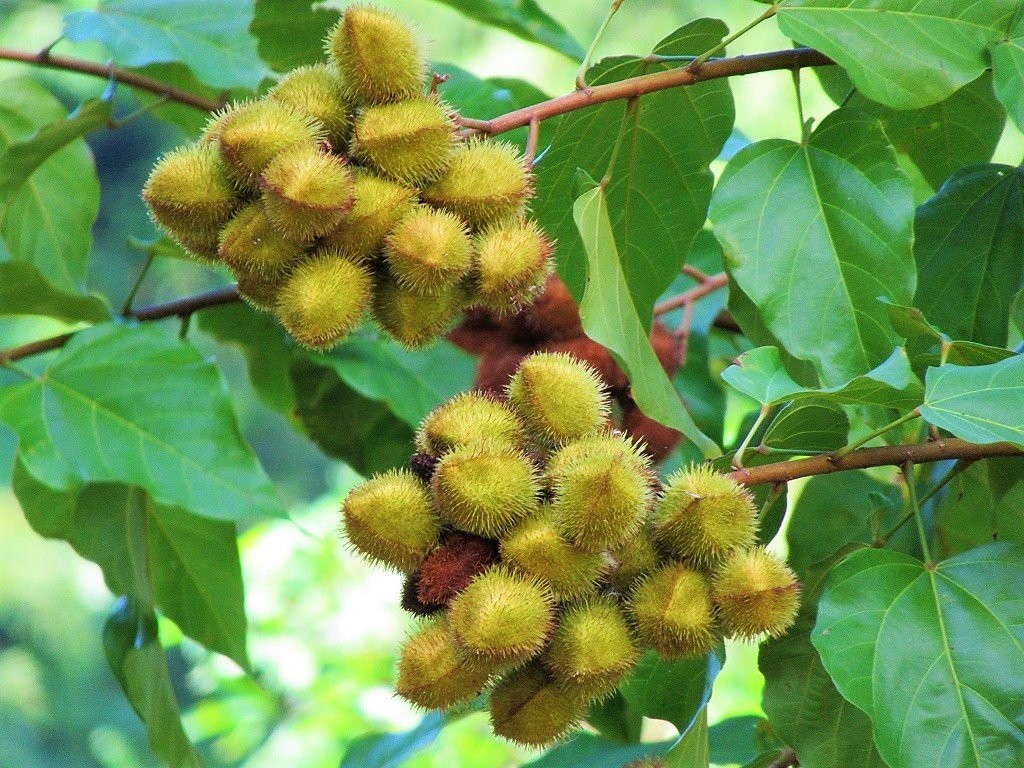 Lipstick Tree, Vietnam
Lipstick Tree, Vietnam
The Lipstick Tree, recognizable by its diamond-shaped pods, grows in clusters on thin branches in the Central and Northern Highlands. Its seeds are used as a red-pink dye called annatto, coloring foods worldwide, including broths in Vietnam and Red Leicester cheese in the UK.
1.19 Morning Glory (Convolvulus, Hoa Rau Muống)
 Convolvulus, morning glory flower, Vietnam
Convolvulus, morning glory flower, Vietnam
Morning Glory grows by beaches and rivers throughout Vietnam, with hundreds of species of convolvulus thriving near water. These plants feature small, delicate flowers in white, pink, purple, and blue, and are commonly used in the dish rau muống xào tỏi—stir-fried morning glory in garlic.
1.20 Golden Shower (Cassia Fistula, Hoa Hoàng Yến, Cây Osaka)
The Golden Shower tree blooms in coastal regions of Vietnam from March to June. Its vibrant color transforms the trees into chandeliers of candles lining the streets, creating a magical and striking spectacle.
1.21 Peacock Flower (Hoa Kim Phượng, Hoa Phượng)
The Peacock Flower, a shrub with small green leaves and bright red flowers with a yellow tinge, is fairly common in the tropical south and central regions of Vietnam. It adds a lively splash of color to city parks and gardens.
1.22 Rose Myrtle (Hoa Sim)
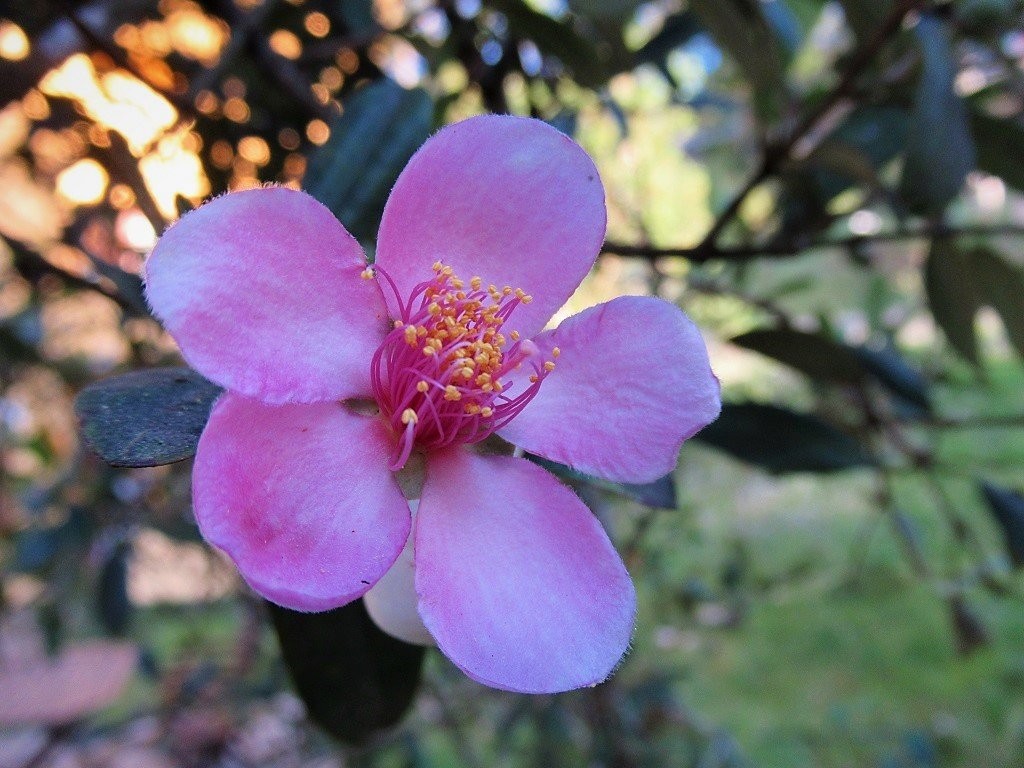 Rose Myrtle Flower, Vietnam
Rose Myrtle Flower, Vietnam
Rose Myrtle, a dark green bush common in the Central Highlands, features very pretty, violet flowers. Its dark berries are used to make rượu sim, a potent, flowery-flavored liquor found around Dalat and Phu Quoc Island.
1.23 Poinsettia (Christmas Star, Hoa Trạng Nguyên)
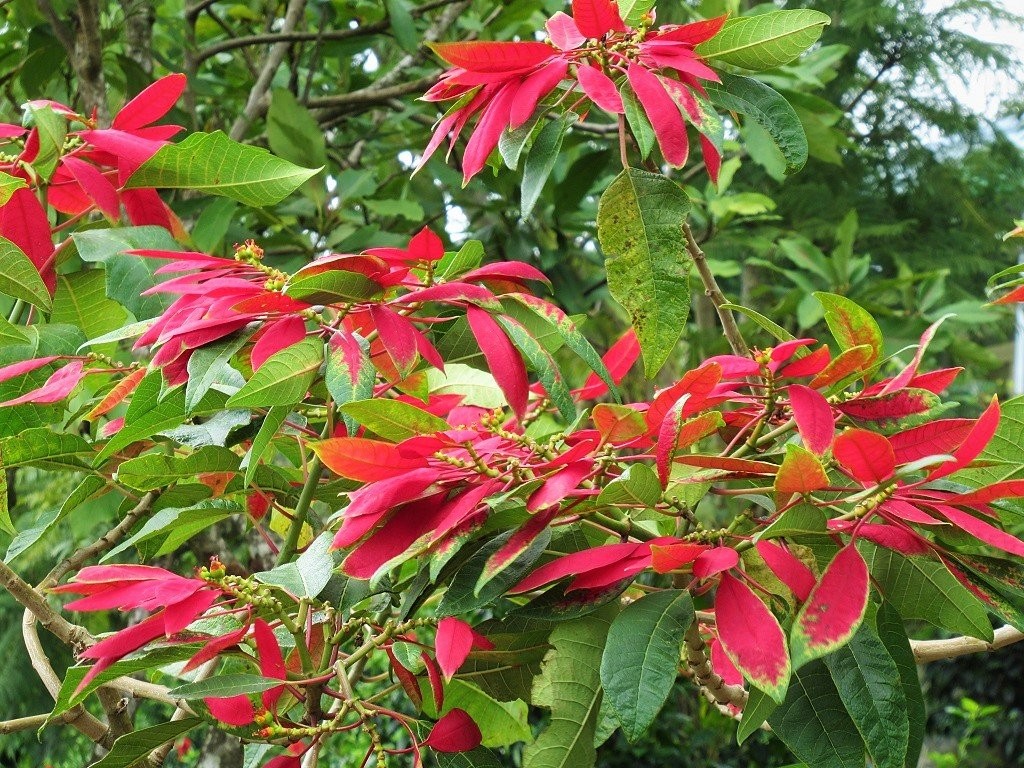 Poinsettia Flower, Vietnam
Poinsettia Flower, Vietnam
Poinsettias, easily recognizable by their blood-red leaves, grow in the Central Highlands of Vietnam. These small green trees with bursts of red leaves are a common sight in and around Dalat, where temperatures are cooler.
1.24 Heliconia (Lobster Claws, Chi Chuối Pháo)
 Heliconia flower, Vietnam
Heliconia flower, Vietnam
Heliconia, a highly decorative and distinctive plant, comes in many colorful varieties and is often used in resort gardens. These plants feature broad, stiff, green leaves and stork-like stems that burst open in a cascade of colorful, beak-like flowers.
1.25 Yellow Mai Flower (Apricot Blossom, Tet Flower, Hoa Mai Vàng)
 Yellow Mai Flower, Tet Lunar New Year flower, Vietnam
Yellow Mai Flower, Tet Lunar New Year flower, Vietnam
The Yellow Mai, known as the ‘Tet Flower’, adorns almost every household in southern Vietnam during Lunar New Year (Tet). Its bright, papery, and pretty little bush symbolizes prosperity for the coming year.
1.26 Adenium (Desert Rose, Sứ Sa Mạc)
 Adenium flower, Desert Rose, Vietnam
Adenium flower, Desert Rose, Vietnam
Adenium, a pink, tubular flower on a stark bush, is often found as a potted plant in gardens and temple grounds. Related to the Frangipani, its sap is highly poisonous, but its pleasing appearance is deceiving.
1.27 Lotus Flower (Sacred Lotus, Hoa Sen)
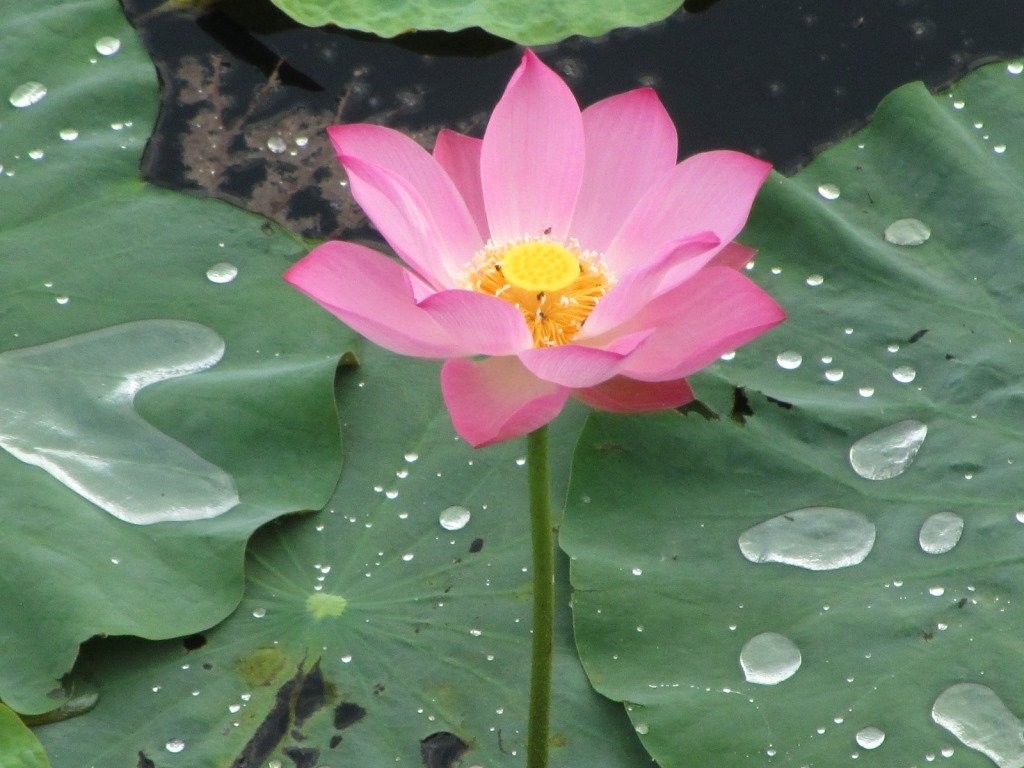 Lotus Flower, Vietnam
Lotus Flower, Vietnam
The Lotus, Vietnam’s national flower, grows in freshwater ponds and lakes throughout the country. As a sacred flower for Buddhists and Hindus, it symbolizes purity and is used in various ways, from decorative purposes to culinary dishes and teas.
2. What Kinds Of Fruits And Trees Are Commonly Seen In Vietnam?
Various kinds of fruits and trees are commonly seen in Vietnam. Vietnam’s landscape is adorned with a diverse array of fruit-bearing trees, contributing to its lush scenery and rich culinary traditions. Here are some of the most frequently seen fruit trees:
2.1 Flame Tree (Phượng Vĩ, Delonix Regia)
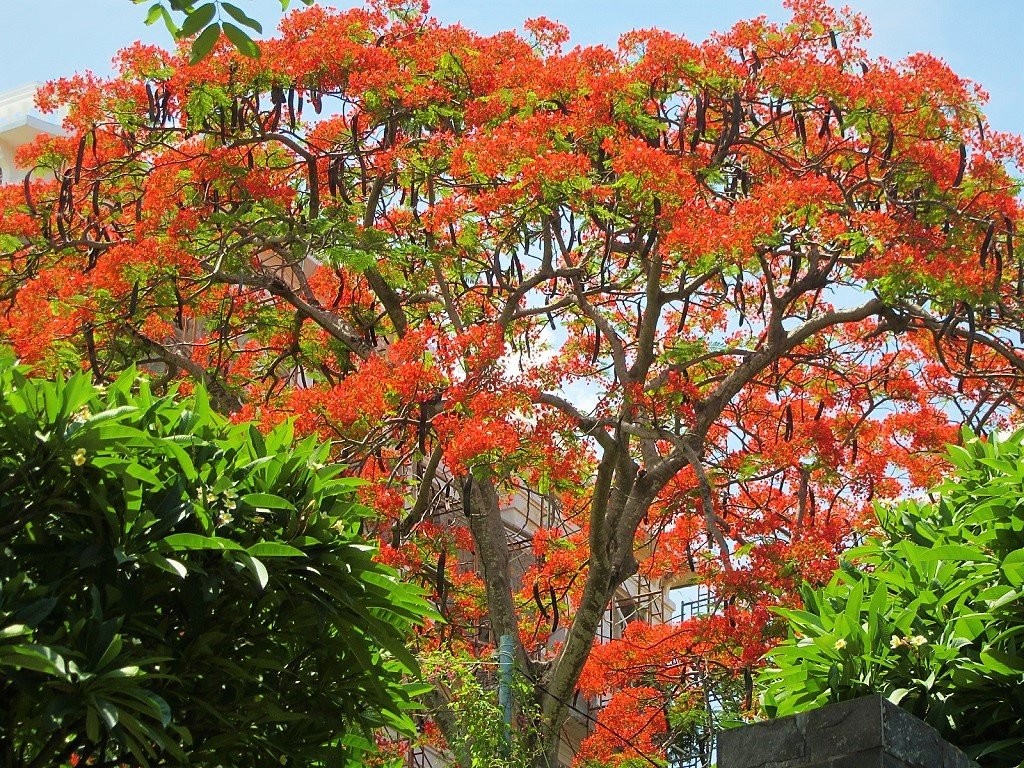 Flame tree, Vietnam
Flame tree, Vietnam
The Flame Tree, a popular icon of Vietnam, especially in the southern and central provinces, is admired for its bright red flowers against a clear blue sky. Blooming from late spring to early summer (April-June), it’s found throughout Vietnam, except in higher mountainous regions.
2.2 Jackfruit Tree (Cây Mít)
 Jackfruit tree, Vietnam
Jackfruit tree, Vietnam
The Jackfruit Tree, bearing the world’s largest tree-borne fruit, is common in the south and central coast and the Central Highlands. Its enormous, bulbous fruit with light green, textured skin is widely eaten fresh or cooked, and has a distinctive sweet and pungent odor.
2.3 Copperpod Tree (Yellow Flame Tree)
 Copperpod tree, Vietnam
Copperpod tree, Vietnam
The Copperpod Tree, named for its shiny brown seedpods, is a common tree in Vietnamese towns and cities. These medium-sized trees often line main streets and boulevards, lighting up city streets with their yellow flowers in springtime.
2.4 Teak Tree (Cây Tếch, Gía Ty)
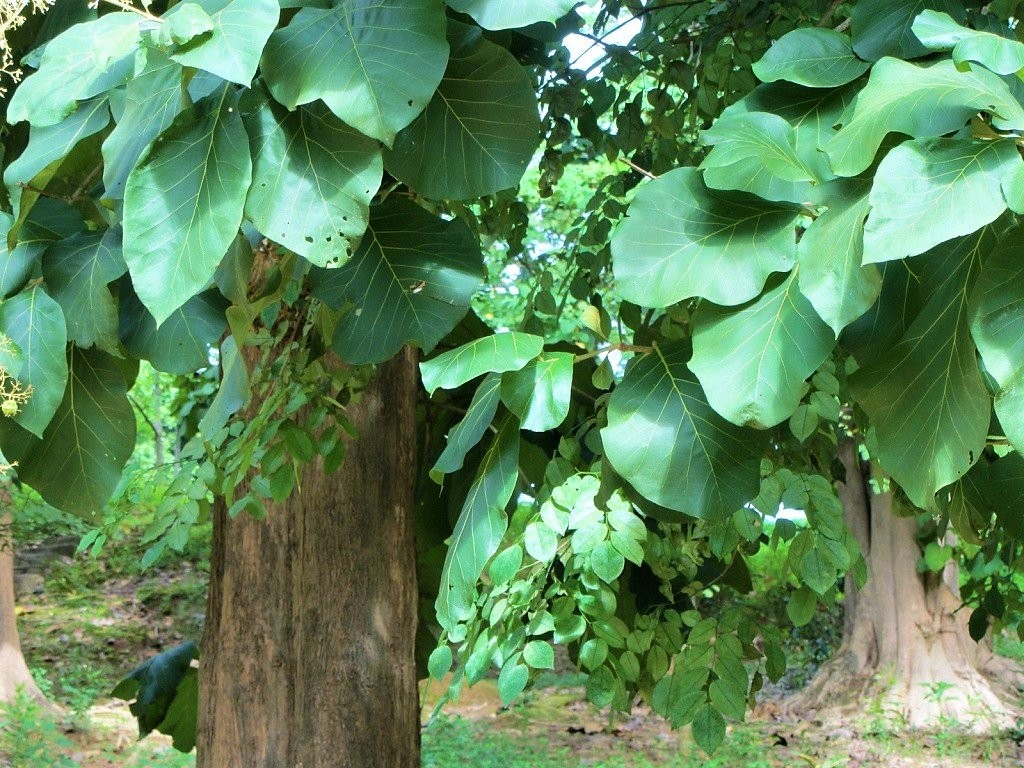 Teak tree, Vietnam
Teak tree, Vietnam
The Teak Tree, a quintessential tropical hardwood tree, is found in pockets throughout Vietnam’s highlands. With strikingly straight trunks and large leaves, Teak is a valuable wood used for expensive furniture.
2.5 Coconut Palm (Cây Dừa)
 Coconut palm tree, Vietnam
Coconut palm tree, Vietnam
The Coconut Palm, the unofficial global symbol of the tropics, grows all over the southern and central coastal regions. Its benevolent and calming presence promises warm weather and sea breezes, providing coconuts for drinking and leaves for various uses.
2.6 Tropical Almond Tree (Umbrella Tree, Cây Bàng)
 Tropical almond tree (Umbrella tree), Vietnam
Tropical almond tree (Umbrella tree), Vietnam
The Tropical Almond Tree, also known as the Umbrella Tree, is seen all across coastal regions of Vietnam. With shapely, thick leaves and horizontal branches, it provides a wide pool of shade and delicious nuts.
2.7 Indian Milkwood Pine (Devil Tree, Cây Hoa Sữa)
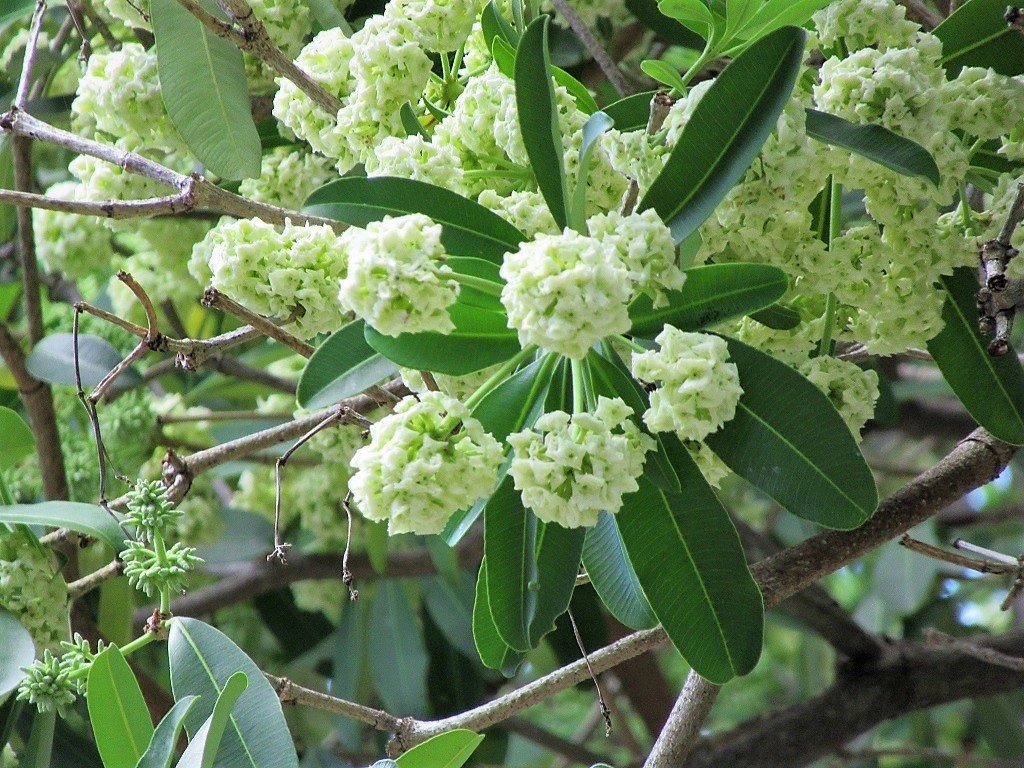 Indian Milkwood tree, cây hoa sữa, Vietnam
Indian Milkwood tree, cây hoa sữa, Vietnam
The Indian Milkwood, known for its white flowers, releases an intoxicating aroma around October in cities and the countryside. Its spicy scent evokes Asian and exotic spices, though some people are allergic to it.
2.8 Tamarind Tree (Indian Date, Cây Me)
The Tamarind Tree, often centuries old, thrives in sunny, hot, arid conditions in the Vietnamese countryside. Its copper-colored pods reveal sour-sweet seeds used in various culinary applications.
2.9 Prickly Pear Cactus (Xương Rồng, Opuntia)
 Prickly Pear Cactus, Vietnam
Prickly Pear Cactus, Vietnam
The Prickly Pear Cactus, found in the dry coastal plains of the south-central provinces, features green, thorny structures and pinkish fruit. Known as Xương Rồng or “Dragon Bones,” these cacti are linked to myths and legends.
2.10 Star Apple (Milk Fruit, Vú Sữa)
 Star Apple (Vú Sữa) fruit, Vietnam
Star Apple (Vú Sữa) fruit, Vietnam
The Star Apple, a common and much-loved tropical fruit in the south of Vietnam, features almost perfectly spherical fruit with glossy skin. Known as vú sữa or “breast milk,” its milky flesh is juicy, sticky, refreshing, and delicious.
2.11 Kapok Tree (Silk Cotton Tree, Cây Gòn)
 Kapok tree, Vietnam
Kapok tree, Vietnam
The Kapok Tree, with its buttressed roots and long, gourd-shaped seedpods, is a striking sight in midland regions. Its silvery cotton-like material is used for bedding and insulating homes, and is often associated with folklore.
2.12 Papaya Tree (Pawpaw, Cây Đu Đủ)
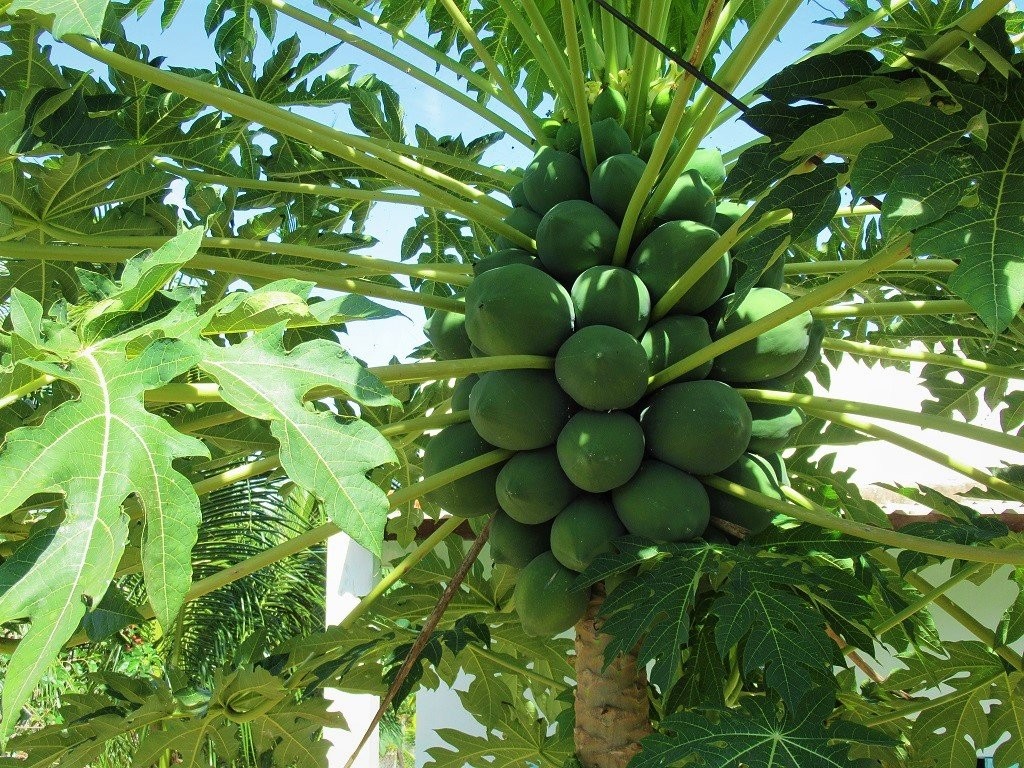 Papaya tree, Vietnam
Papaya tree, Vietnam
The Papaya Tree, with a burst of star-shaped leaves and clusters of fruit, is quintessentially exotic and tropical. Its fruit is a staple in Vietnamese cuisine, used in salads, smoothies, and desserts.
2.13 Traveller’s Palm (Ravenala, Chuối Quạt)
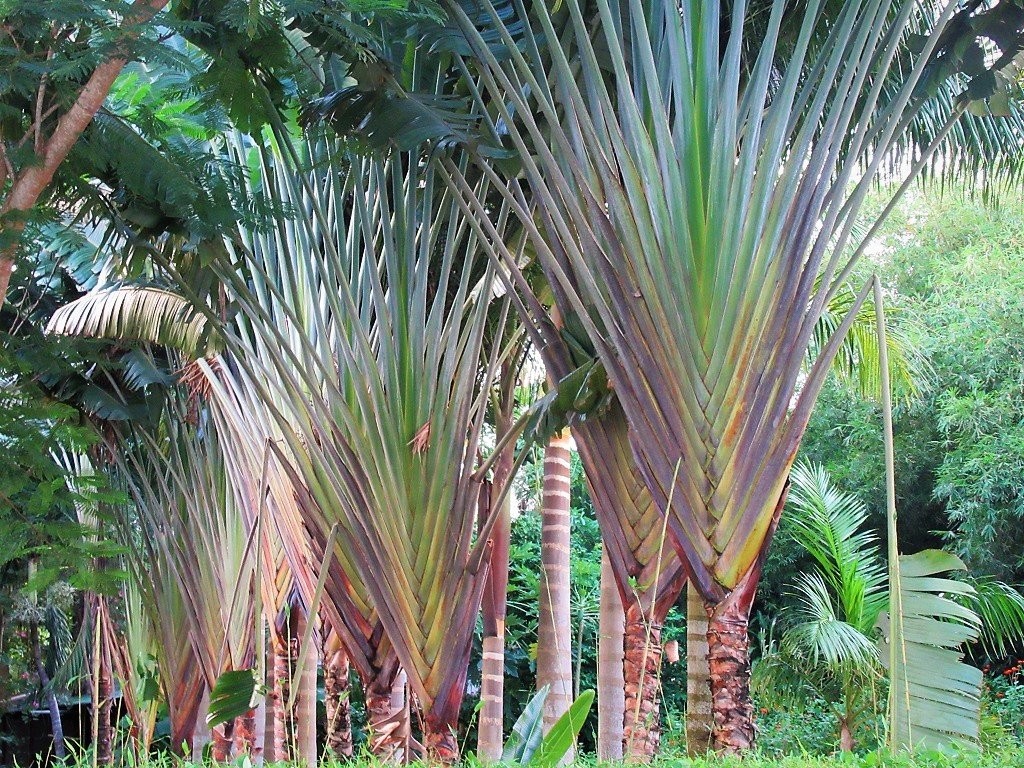 Traveller
Traveller
The Traveller’s Palm, originating from Madagascar, is a favorite decorative tree in Vietnam. Its long, grooved stems bring rainwater down from the leaves to the trunk, providing a water supply for thirsty travellers.
2.14 Persimmon Tree (Qủa Hồng)
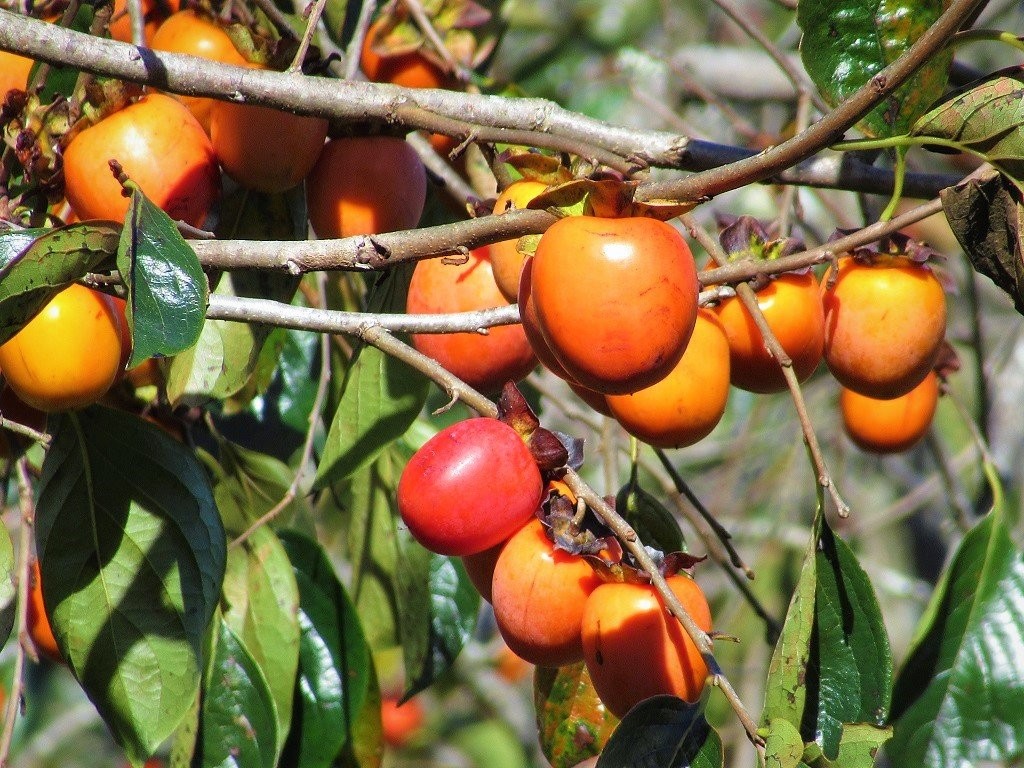 Persimmon fruit tree, Vietnam
Persimmon fruit tree, Vietnam
Persimmon Trees, associated with autumnal weather, are found in the cool air of the Central Highlands around Dalat. Their orange-red fruit, hanging like decorative balls, is eaten raw or dried and candied.
2.15 Grape Vine (Vitis, Chi Nho)
 Grapes, Ninh Thuan Province, Vietnam
Grapes, Ninh Thuan Province, Vietnam
The Grape Vine thrives in the arid coast and inland plains of Ninh Thuan, where grapes are grown for wine production, honey, raisins, and candies. Introduced by the colonial French, the region continues to cultivate grapes, though the wine is generally called Dalat Wine.
2.16 Casuarina Tree (Cây Phi Lao)
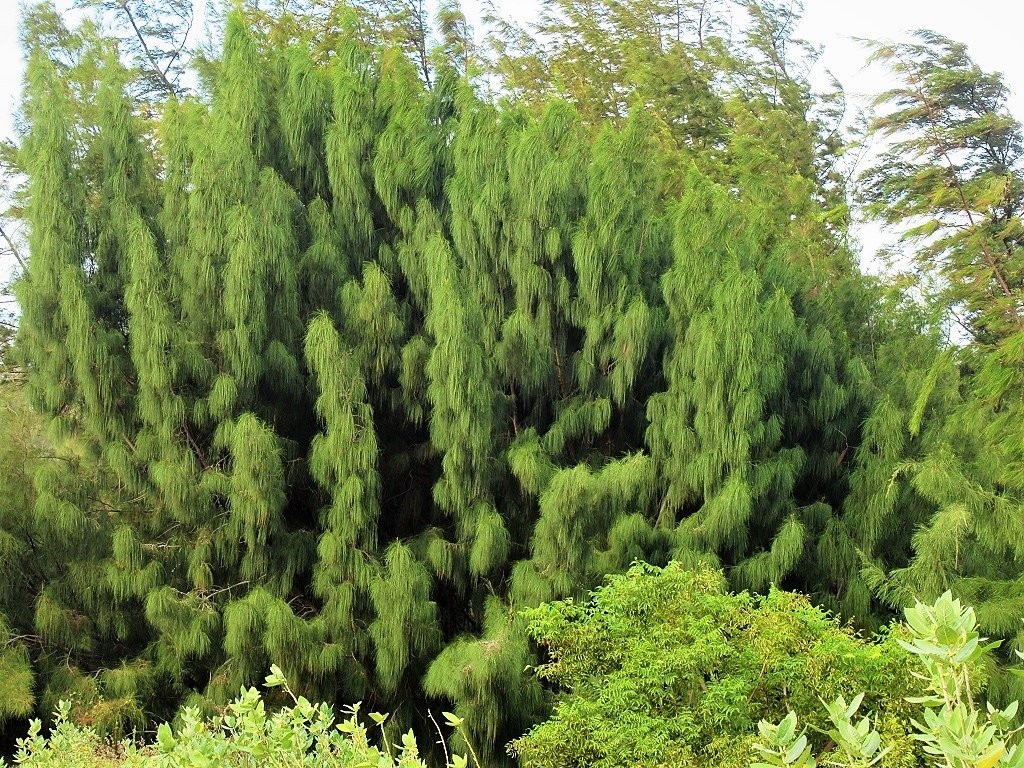 Casuarina Tree, Vietnam
Casuarina Tree, Vietnam
Casuarina Trees, with their pine-like appearance and slender needles, are found along Vietnam’s long coastline. These tall, whispering trees with a silver glow often grow in the brackish water between the beach and the ocean.
2.17 Dragon Fruit Tree (Pitaya, Thanh Long)
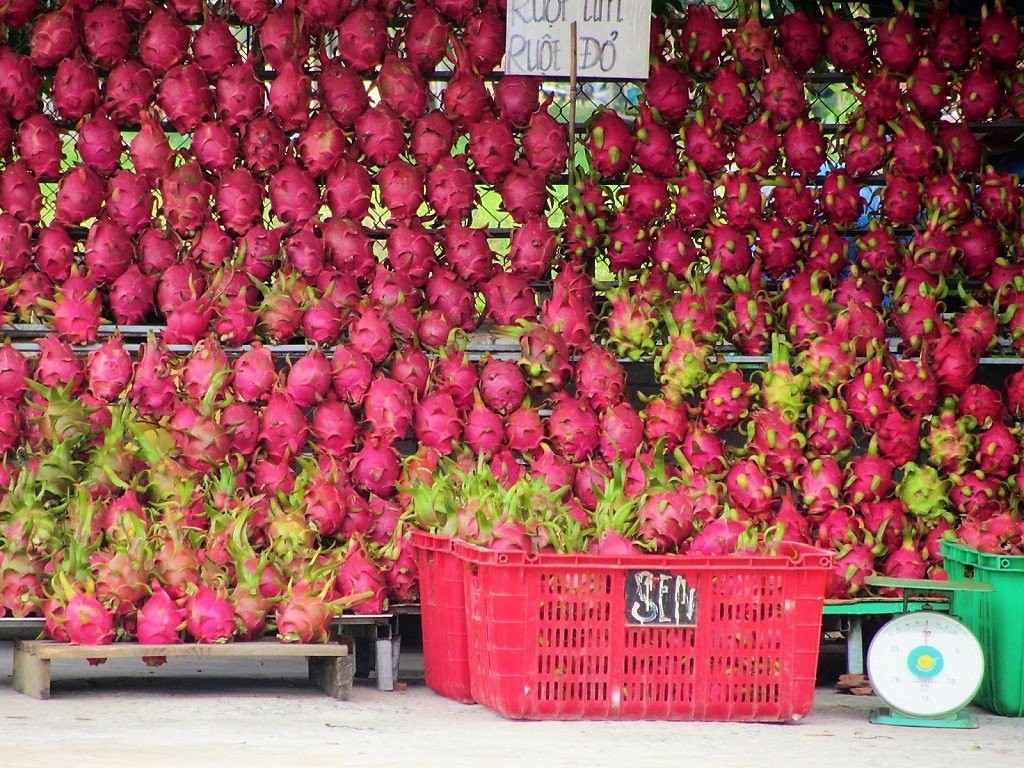 Dragon Fruit, Vietnam
Dragon Fruit, Vietnam
The Dragon Fruit Tree, found in dry southern coastal regions like Binh Thuan, bears the exotic-looking and colorful Dragon Fruit. The plantations are illuminated at night, creating a patchwork of glowing fields.
2.18 Chilli Pepper (Ớt)
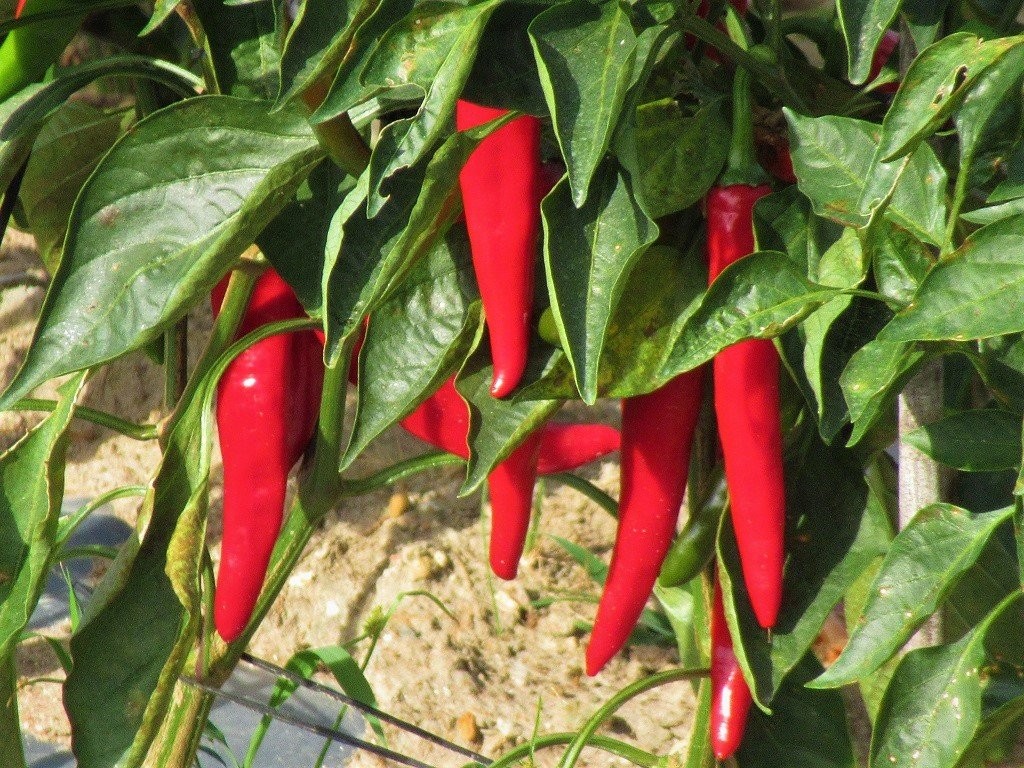 Chilli Pepper bush, Vietnam
Chilli Pepper bush, Vietnam
Red Chillies, used in many Vietnamese dishes, are grown in the hotter, drier regions, such as the south and central coast. The small, red peppers, known for their spicy flavor and flowery aroma, grow on small and delicate plants.
2.19 Banyan Tree (Strangler Fig, Cây Đa)
 Banyan Tree, Strangler Fig, Vietnam
Banyan Tree, Strangler Fig, Vietnam
The Banyan Tree, a grand and majestic tree, is considered the king of trees in Asia. It can grow to enormous sizes and live for many centuries, with some trees being worshiped for the spirits dwelling within.
2.20 Bodhi Tree (Ficus Religiosa, Sacred Fig, Cây Bồ Đề)
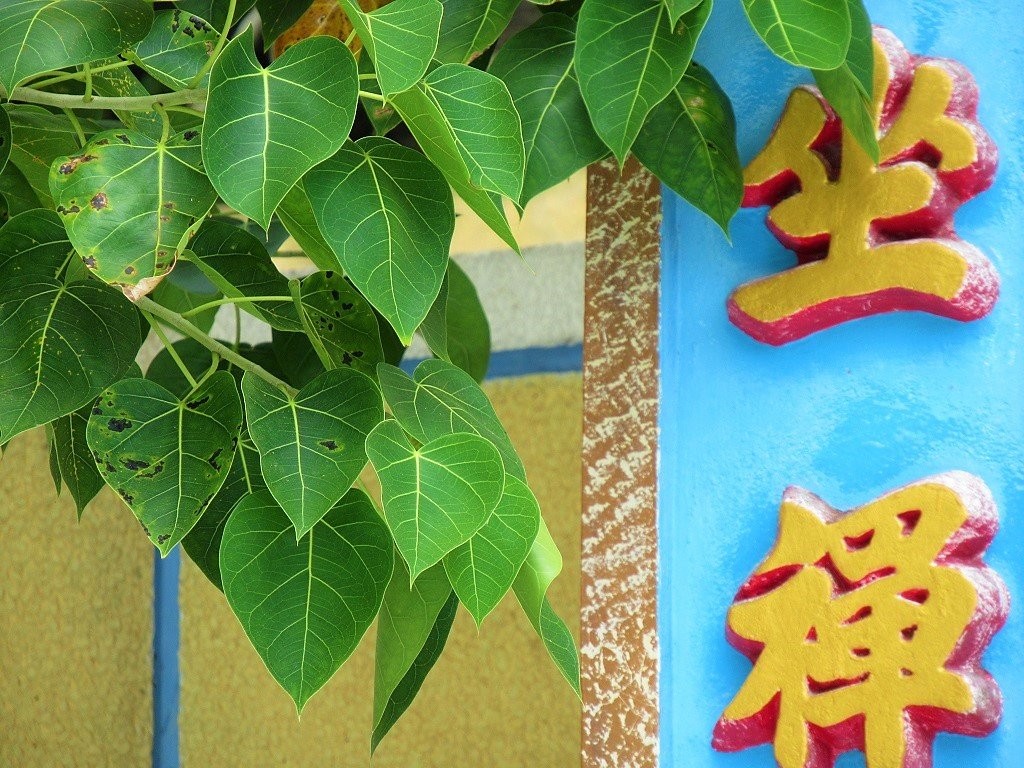 Bodhi Tree, Vietnam
Bodhi Tree, Vietnam
The Bodhi Tree, famous as the tree under which Siddhartha Gautama attained enlightenment, has strong spiritual associations and is found in most temple grounds in Vietnam. Its heart-shaped leaves and distinctive canopy make it easily recognizable.
2.21 Peanut (Monkey Nut, Đậu Phộng, Lạc)
Peanuts, grown in fields in central and northern coastal plains, feature a low, shrub-like plant with small leaves. The nuts, growing underground in pods, are commonly used in Vietnamese cuisine as a garnish.
2.22 Cannonball Tree (Đầu Lân)
The Cannonball Tree, named for its large, brown, spherical fruit, features large, wide, and open flowers with cream yellow petals on the outside and deep red on the inside. Its flowers have a rubbery texture and a glorious scent.
2.23 Bamboo (Tre)
 Bamboo in Vietnam
Bamboo in Vietnam
Bamboo, with poetic and romantic associations in Vietnamese culture, is a versatile and strong plant used for homes, piping, food, and utensils. There are thousands of varieties of bamboo, especially by rivers and in the hills of central and northern provinces.
2.24 Cashew Tree (Cây Điều, Đào Lộn Hột)
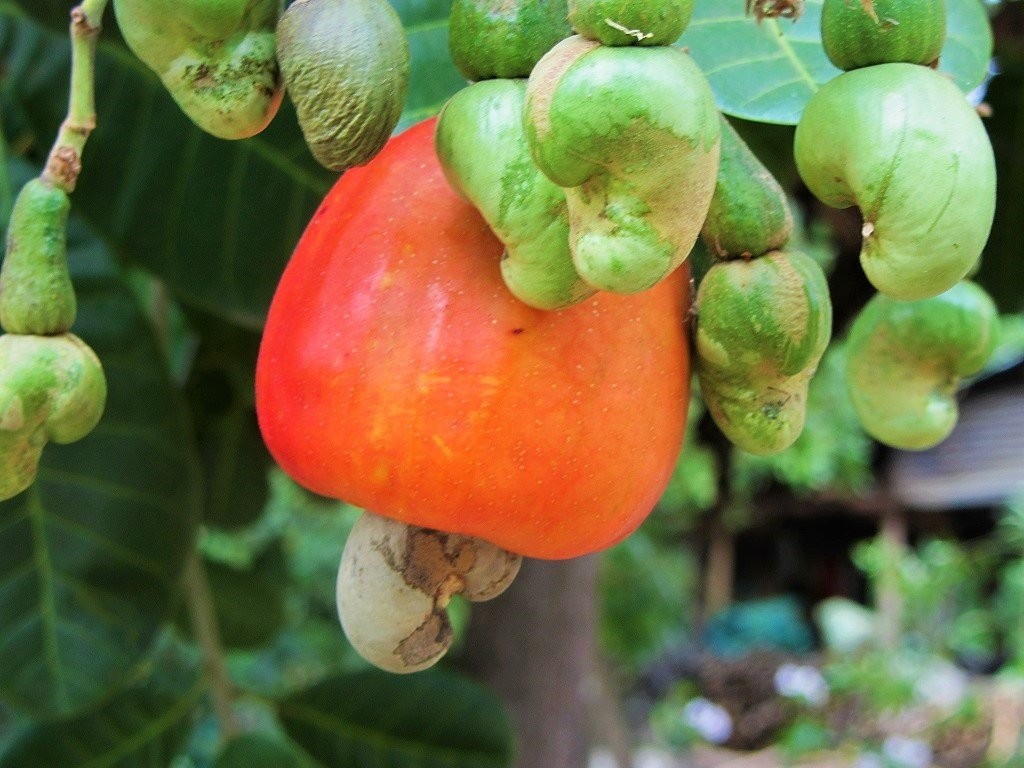 Cashew fruit & nut, Vietnam
Cashew fruit & nut, Vietnam
The Cashew Tree, found in open orchards in coastal and lowland regions, bears the famous nut and a juicy fruit. Its nut grows attached to the bottom of the Cashew apple, and the tree is known for its splayed branches and thick leaves.
2.25 Mango Tree (Cây Xoài)
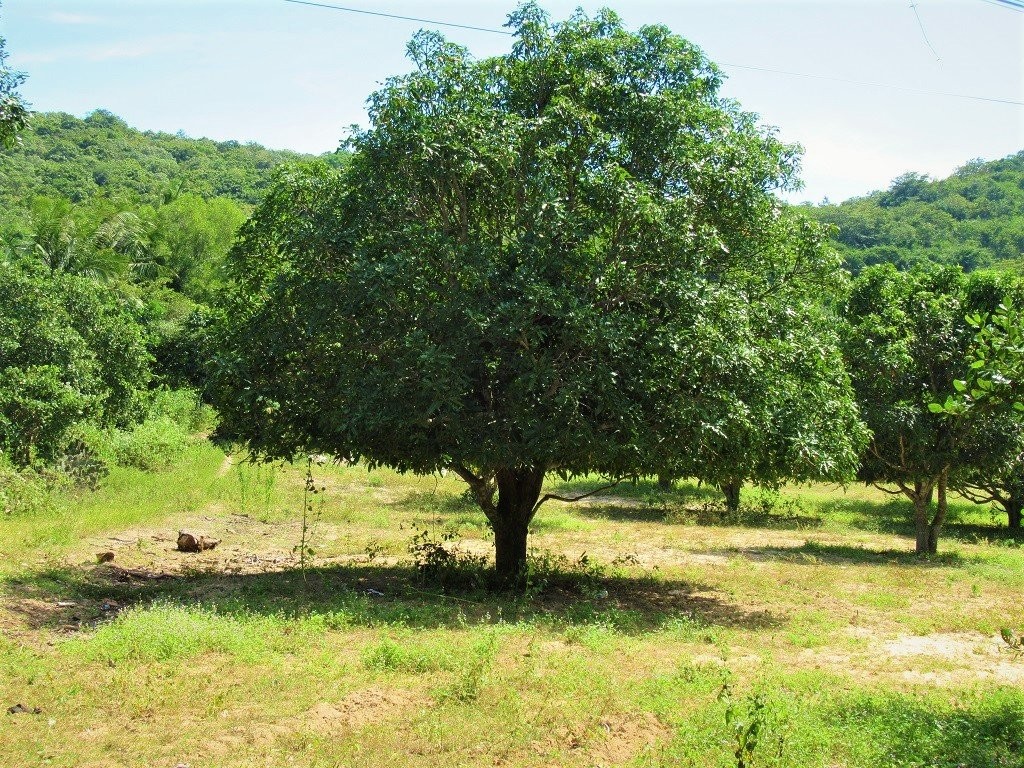 Mango Tree, Vietnam
Mango Tree, Vietnam
Mangoes are widely available in Vietnam, with Mango Trees growing in gardens, by roadsides, and in orchards. With a pleasing symmetry and dozens of varieties, Mangoes are used in green salads or enjoyed as ripe, sweet, juicy fruit.
2.26 Coffee Bush (Chi Cà Phê)
 Coffee plant, Vietnam
Coffee plant, Vietnam
The Coffee Bush, a squat, glossy-green shrub, blankets parts of the Vietnamese countryside, especially in the Central Highlands. Vietnam is one of the world’s largest producers and exporters of coffee.
2.27 Breadfruit Tree (Cây Sa Kê)
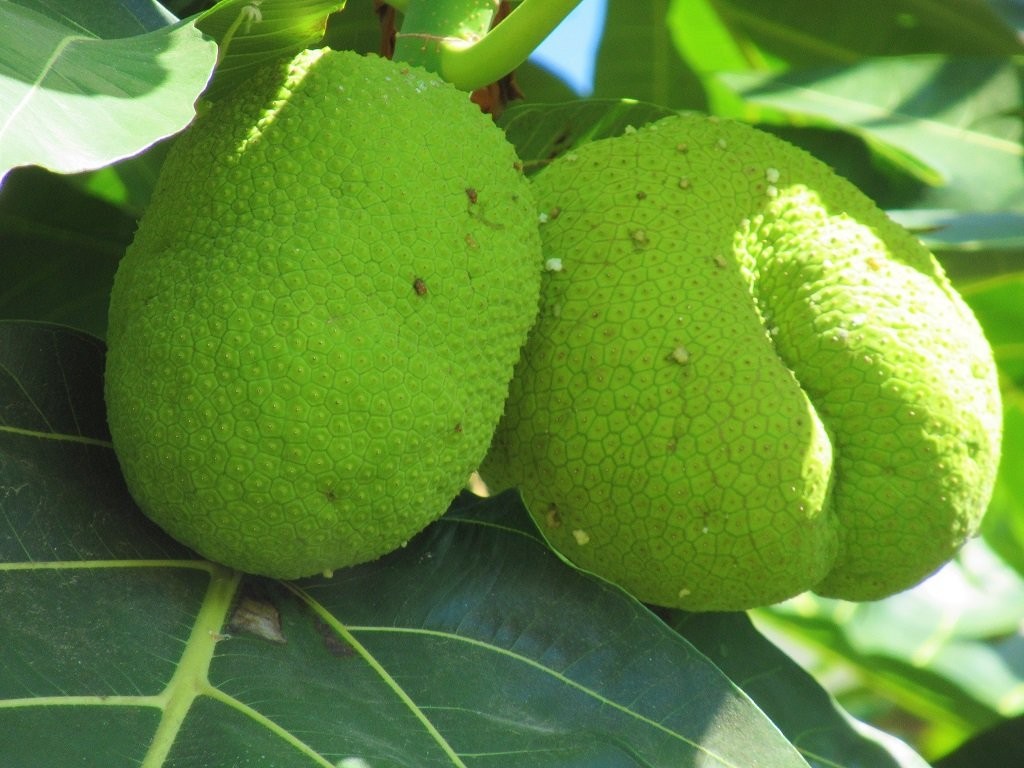 Breadfruit tree, Vietnam
Breadfruit tree, Vietnam
The Breadfruit Tree, a handsome tree with large, green, coarsely textured leaves, is common as an ornamental tree on city streets and in gardens. Its big, green-yellow fruit is used as a starchy alternative to potatoes.
3. When Is The Best Time To See Flowers In Vietnam?
The best time to see flowers in Vietnam depends on the region and the specific flowers you’re interested in. Here’s a general guide:
- Spring (February to April): This is when many flowers are in full bloom, especially in the northern regions. The Tet holiday (Lunar New Year) sees the blossoming of peach blossoms (hoa đào) in the north and apricot blossoms (hoa mai) in the south.
- Summer (May to August): The central highlands are vibrant with wildflowers, while the coastal areas boast colorful blossoms like bougainvillea and hibiscus.
- Autumn (September to November): The rice terraces in the northern mountains turn golden, and you can still find many wildflowers in bloom.
- Winter (December to February): The cooler climate in Dalat and the central highlands makes it an ideal time to see flowers like poinsettias and sunflowers.
4. Where Are The Best Places To See Flowers And Trees In Vietnam?
The best places to see flowers and trees in Vietnam are spread across its diverse landscapes. Here are some standout locations:
- Dalat: Known as the “City of Flowers,” Dalat in the Central Highlands is renowned for its vibrant flower gardens, including hydrangeas, roses, and orchids.
- Sapa: The mountainous region of Sapa in northern Vietnam is famous for its terraced rice fields and diverse flora, especially during the spring when wildflowers bloom.
- Hanoi: The capital city offers numerous parks and botanical gardens where you can see a variety of trees and flowers. The Hoan Kiem Lake area is also adorned with colorful blossoms.
- Mekong Delta: The Mekong Delta is home to numerous waterways filled with water lilies and lotus flowers, creating picturesque scenes.
- Coastal Regions: The coastal regions, particularly around Nha Trang and Phu Quoc, are adorned with bougainvillea, hibiscus, and coconut palms, creating stunning seaside landscapes.
5. What Are Some Unique Trees Found In Vietnam?
Vietnam is home to several unique trees. Some notable examples include:
- Banyan Tree (Cây Đa): Known for its aerial roots and massive canopy, the Banyan tree is often considered sacred and can be found near temples and historical sites.
- Bodhi Tree (Cây Bồ Đề): Also known as the Sacred Fig, the Bodhi tree is revered in Buddhism as the tree under which Siddhartha Gautama attained enlightenment.
- Dragon Fruit Tree (Thanh Long): This unique cactus-like tree is cultivated for its vibrant pink fruit and can be found in the coastal regions of southern Vietnam.
- Cannonball Tree (Đầu Lân): This tropical tree is distinguished by its large, spherical fruits that resemble cannonballs hanging from the branches.
6. How Can I Plan A Trip To See The Flowers And Trees Of Vietnam?
Planning a trip to see the flowers and trees of Vietnam can be an exciting adventure. Here are some steps to consider:
- Determine the Season: Choose the time of year based on the specific flowers and trees you want to see. Spring and early summer are generally good for a wide variety of blooms.
- Select Regions: Decide which regions to visit based on your interests. Dalat, Sapa, and the Mekong Delta are popular choices.
- Plan Your Itinerary: Create a detailed itinerary that includes specific destinations, such as botanical gardens, national parks, and scenic routes.
- Book Accommodations: Reserve accommodations in advance, especially during peak tourist seasons.
- Arrange Transportation: Plan your transportation within Vietnam. Options include domestic flights, trains, buses, and rental cars. SIXT.VN offers convenient airport transfer and car rental services to help you get around easily.
- Engage Local Guides: Consider hiring local guides for deeper insights into the flora and fauna of each region.
7. How Do Vietnamese People Use Flowers In Their Daily Lives?
Flowers hold significant cultural value in Vietnam, used in various aspects of daily life:
- Decoration: Flowers are commonly used to decorate homes, temples, and public spaces, bringing beauty and freshness to the surroundings.
- Offerings: Flowers are an essential part of religious offerings, symbolizing purity and devotion. Lotus flowers, in particular, are highly valued in Buddhist ceremonies.
- Gifts: Flowers are often given as gifts on special occasions, such as birthdays, anniversaries, and graduations, expressing love and appreciation.
- Culinary Uses: Some flowers are used in Vietnamese cuisine, adding unique flavors and aromas to dishes. For example, banana blossoms and squash blossoms are used in salads and soups.
- Traditional Medicine: Certain flowers and plants are used in traditional medicine for their healing properties, passed down through generations.
8. Are There Any Flower Festivals Or Events In Vietnam?
Yes, there are several flower festivals and events in Vietnam. Attending these festivals offers a unique opportunity to experience the beauty and cultural significance of flowers:
- Dalat Flower Festival: Held biennially in Dalat, this festival showcases the city’s stunning array of flowers and includes exhibitions, parades, and cultural performances.
- Tet Flower Markets: During the Tet holiday (Lunar New Year), vibrant flower markets pop up in cities and towns across Vietnam, offering a wide variety of blooms and decorations.
- Hoi An Lantern Festival: Although not exclusively a flower festival, this monthly event features beautiful flower lanterns along the streets of Hoi An, creating a magical atmosphere.
- Lim Festival: This traditional festival in Bac Ninh province includes flower offerings, folk songs, and cultural activities celebrating the region’s heritage.
9. What Tips Can You Give For Photographing Flowers And Trees In Vietnam?
Photographing flowers and trees in Vietnam can result in stunning images. Here are some tips to help you capture the best shots:
- Golden Hour: Shoot during the golden hour (early morning or late afternoon) for soft, warm light that enhances colors and textures.
- Composition: Use the rule of thirds to create visually appealing compositions. Place the flower or tree slightly off-center to add interest.
- Background: Pay attention to the background and choose a simple, uncluttered backdrop to make the subject stand out.
- Macro Lens: Use a macro lens to capture intricate details of flowers and leaves.
- Diffused Light: On bright days, use a diffuser or find shade to soften the light and reduce harsh shadows.
- Polarizing Filter: Use a polarizing filter to reduce glare and enhance colors, especially when shooting near water or in bright sunlight.
- Experiment with Angles: Try different angles to find the most flattering perspective. Shoot from low angles to emphasize height and grandeur, or from above to capture patterns and shapes.
10. Can SIXT.VN Help Me Plan My Flower And Tree Tour In Vietnam?
Yes, SIXT.VN can definitely help you plan your flower and tree tour in Vietnam. We offer a range of services to make your trip seamless and enjoyable:
- Personalized Itineraries: We can create custom itineraries based on your interests, including visits to botanical gardens, national parks, and scenic routes known for their flora.
- Airport Transfers: Our reliable airport transfer service ensures a smooth arrival and departure, taking you directly to your accommodation.
- Car Rental: Explore Vietnam at your own pace with our car rental services. We offer a variety of vehicles to suit your needs, from compact cars for city driving to SUVs for exploring the highlands.
- Accommodation Assistance: We can assist you in finding and booking accommodations that suit your preferences and budget, whether you’re looking for luxury resorts or cozy guesthouses.
- Local Guides: We can connect you with knowledgeable local guides who can provide insights into Vietnam’s flora and cultural significance.
- Travel Tips: Our team can offer valuable travel tips to enhance your experience, including the best times to



